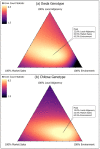Distribution of Theileria orientalis in Virginia Market Cattle, 2018-2020
- PMID: 36422604
- PMCID: PMC9695988
- DOI: 10.3390/pathogens11111353
Distribution of Theileria orientalis in Virginia Market Cattle, 2018-2020
Abstract
Theileria orientalis, genotype Ikeda, was recently detected in North America. Determining the emerging distribution of this pathogen is critical for understanding spread and developing management strategies. Whole blood samples were collected from cattle at Virginia livestock markets from September 2018 through December 2020. Animals were tested for T. orientalis using a universal and then genotype specific real-time PCR based on the MPSP gene. Prevalence for each genotype was analyzed for temporal trends and mapped by county. Spatial patterns were compared between genotypes and assessed for associations with habitat features, cattle movements through cattle markets and county proximity. Overall, 212 of 1980 samples tested positive for T. orientalis with an overall prevalence of 8.7% (172/1980) for genotype Ikeda, 1.8% (36/1980) for genotype Chitose, 0.2% (3/1980) for genotype Buffeli. The Ikeda genotype increased over time in northern and southwestern Virginia markets. The Ikeda and Chitose genotypes occurred in different regions, with little overlap, but for each genotype, spatial distribution was associated with a combination of cattle movements and environmental factors. Genotype specific qPCR testing and surveillance of cattle from across a wide area of Virginia are providing information on temporal, spatial, and other patterns for this emerging disease.
Keywords: Chitose genotype; Ikeda genotype; Theileria orientalis; prevalence; spatial distribution.
Conflict of interest statement
The authors declare no conflict of interest.
Figures





References
-
- Dinkel K.D., Herndon D.R., Noh S.M., Lahmers K.K., Todd S.M., Ueti M.W., Scoles G.A., Mason K.L., Fry L.M. A U.S. isolate of Theileria orientalis, Ikeda genotype, is transmitted to cattle by the invasive Asian longhorned tick, Haemaphysalis longicornis. Parasit. Vectors. 2021;14:157. doi: 10.1186/s13071-021-04659-9. - DOI - PMC - PubMed
-
- Lawrence K., Lawrence B., Hickson R., Hewitt C., Gedye K., Fermin L., Pomroy W. Associations between Theileria orientalis Ikeda type infection and the growth rates and haematocrit of suckled beef calves in the North Island of New Zealand. N. Z. Vet. J. 2019;67:66–73. doi: 10.1080/00480169.2018.1547227. - DOI - PubMed
Grants and funding
LinkOut - more resources
Full Text Sources

